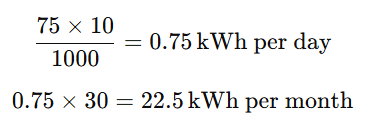Ceiling fans are one of the most widely used household appliances across the world. They provide comfort, improve air circulation, and are far more affordable to operate compared to air conditioners. However, many people overlook one critical factor when choosing a ceiling fan—the wattage of ceiling fan.
Understanding wattage is essential because it directly impacts electricity consumption, energy bills, and overall efficiency. In this detailed guide, we’ll explore what wattage of ceiling fan means, typical ranges, energy consumption calculations, and how you can save money by choosing the right fan.
What Does Wattage of Ceiling Fan Mean?
The wattage of ceiling fan is the measure of how much electrical power the fan consumes when running. It is expressed in watts (W). This value tells you how much energy the fan uses but does not represent its cooling ability—since ceiling fans don’t actually reduce room temperature; they simply circulate air to make the environment feel cooler.
- Low wattage ceiling fan → Consumes less power, ideal for energy savings.
- High wattage ceiling fan → Consumes more power, usually provides stronger airflow.
Example: A ceiling fan rated at 70 watts consumes more electricity than a BLDC fan rated at 35 watts for the same usage time.
Typical Wattage of Ceiling Fan Models
The wattage of ceiling fan depends on its size, blade span, design, and motor efficiency. Below is the general wattage range:
| Fan Size / Type | Typical Wattage | Usage Notes |
| Small ceiling fans (24–36″) | 25–50 W | Suitable for small rooms, kitchens, study areas |
| Medium ceiling fans (42–48″) | 50–75 W | Most common in bedrooms and living rooms |
| Large ceiling fans (52–56″) | 75–90 W | Best for large halls, offices, or commercial spaces |
| High-speed/heavy-duty fans | 90–110 W | Delivers stronger airflow but consumes more electricity |
| BLDC ceiling fans | 28–40 W | Energy-efficient modern fans with brushless DC motors |
For comparison:
- Ceiling fan → 50–90 W
- LED bulb → 8–15 W
- Air conditioner → 1,000–2,000 W
This shows how economical ceiling fans are compared to cooling alternatives.
How to Calculate Energy Consumption from Wattage of Ceiling Fan
You can calculate electricity usage based on fan wattage and operating hours.
Formula:

Example Calculation:
- Fan Wattage = 75 W
- Daily Usage = 10 hours
- Monthly Days = 30

If electricity cost = ₹6 per unit:
22.5×6=₹135 per month (for one fan)
If you use 4 fans regularly, monthly cost = ₹540.
Factors That Influence Wattage of Ceiling Fan
The actual wattage of ceiling fan depends on several factors:
- Fan Size – Larger blades need more power.
- Motor Type –
- Induction motors: 70–90 W (traditional fans).
- BLDC motors: 28–40 W (modern energy-saving fans).
- Speed Setting – A fan at full speed consumes maximum wattage, while at lower speeds, consumption drops significantly.
- Blade Design – Aerodynamic blades improve airflow efficiency and reduce energy use.
- Voltage Supply – Low or fluctuating voltage may impact fan performance and efficiency.
Normal Fan vs BLDC Fan: Wattage and Cost Comparison
Modern BLDC fans (Brushless Direct Current motor fans) are highly efficient and consume almost half the power of a regular fan. Let’s compare:
| Parameter | Normal Ceiling Fan | BLDC Ceiling Fan |
| Wattage of ceiling fan | 70–90 W | 28–40 W |
| Daily usage (10 hrs) | 0.75–0.9 kWh | 0.3–0.4 kWh |
| Monthly consumption | 22.5–27 kWh | 9–12 kWh |
| Monthly cost (₹6/unit) | ₹135–₹162 | ₹54–₹72 |
| Yearly savings | – | ₹972–₹1,080 per fan |
If your home has 5 ceiling fans, switching to BLDC fans can save ₹5,000+ per year.
How to Choose the Right Wattage of Ceiling Fan
When buying a ceiling fan, keep these points in mind:
- Check wattage rating on the product label.
- Prefer BEE Star-rated fans (India) or Energy Star-certified fans (international).
- Opt for BLDC motor fans for maximum savings.
- Match the fan size with room dimensions (oversized fans waste energy).
- Use smart regulators, remotes, or timers to control usage.
Tips to Reduce Electricity Consumption of Ceiling Fans
- Turn off fans when not in use – they don’t cool the room, only people.
- Use natural ventilation (open windows) when possible.
- Combine with LED lights for an overall efficient room setup.
- Keep fan blades clean – dust reduces airflow and forces motor to work harder.
- Maintain proper ceiling height (at least 8–9 ft) for effective circulation.
Conclusion
The wattage of ceiling fan is a key factor in determining energy efficiency and monthly electricity bills. While normal ceiling fans consume around 50–90 watts, modern BLDC fans operate on just 28–40 watts, offering the same airflow at nearly half the power.
By understanding wattage, calculating energy use, and choosing efficient models, you can enjoy comfortable cooling while significantly reducing your electricity expenses. For households with multiple fans, switching to energy-efficient models can lead to substantial yearly savings without compromising comfort.
Related Articles: